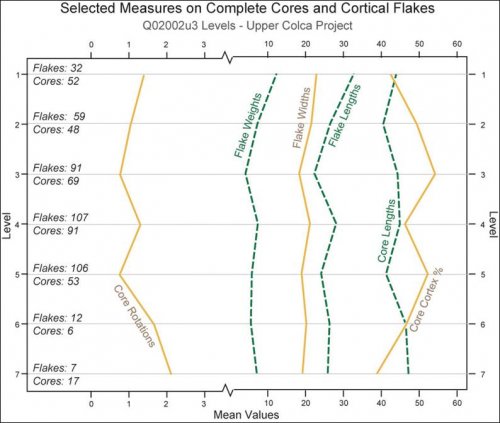Cores compared with Cortical Flakes
Measuring changes in the maximum size of obsidian nodules over time is complicated by the fact that cores become smaller through use. If cores are the subject of export then one can compare the maximum length of early stage reduction cortical flakes (where dorsal cortex ? 50%) with the maximum length of cores as an indicator of the maximum possible size of cores during a given period. However, if large flake blanks are being further reduced and/or exported then large flakes will not be discarded at the workshop and core length may exceed cortical flake length.
Figure 7-23. Q02-u3: Graph showing means of complete cores and cortical flakes.
First, consider the mean values of cores and cortical flakes across excavation levels in their aggregate. The differences between excavation levels using the measures displayed in Figure 7-23 are extremely significant using an ANOVA test of variance.
|
Tech. Class |
Measure |
df |
F |
Signif. |
|
Cores |
Length (mm) |
6 |
2.589 |
.018* |
|
# Rotations |
6 |
6.241 |
.000*** |
|
|
% Cortex |
6 |
3.834 |
.001*** |
|
|
Flakes |
Length (mm) |
6 |
7.168 |
.000*** |
|
Width (mm) |
6 |
4.529 |
.000*** |
|
|
Weight (g) |
6 |
5.968 |
.000*** |
Table 7-20. Q02-2u3: ANOVA on complete cores and flakes with at least 50% dorsal cortex.
In Table 7-20 the observed differences in means are extremely significant ( p? .001) except for the means of core lengths which are significant ( p< .018), confirming that the variability presented in Figure 7-23 is meaningful. The variability in means suggests that specific measures should be investigated in more detail across excavation levels. Changes in means by level on complete cores and cortical flakes as a whole are shown in Figure 7-23 where notable fluctuations on a variety of independent measures that converge around level 4 can be observed.
These differences by level show the relationship between discarded large cores and the cortical flakes that were struck from them. The measures Flake Lengths and Core Lengths show that mean core lengths exceed flake lengths by about 10 cm. The relative decrease of long cortical flakes in level 3, despite the continued availability of long cores, suggests that there was an export of long, heavily reduced cores and large flakes; artifacts that were probably exported as flake blanks.
The absence of cortex on smaller flakes is useful for discriminating advanced reduction flakes from small flakes that simply derived from small cores. Small flakes are abundant in level 3 (as will be shown later below in Figure 7-24) and means in non-normal distributions are sensitive to skewing. One may ask "is the sheer number of smaller flakes in level 3 from more advanced reduction activities, as demonstrated by the presence of broken bifaces in level 3 (discussed earlier), skewing the mean and lowering the mean length of flakes?"
The Pearson's r correlation coefficient between Length and the Percentage Cortex variables is strong on complete flakes from both level 3 and 4, but it is extremely strong in level 4. In level 3 there is a strong correlation between Length (X) and Percentage of Dorsal Cortex (Y) ( r= .203, p= .001, Y = .79X + 19.06). In level 4 the correlation between Length (X) and Cortex (Y) is extremely strong ( r= .330, p= <.0005, Y = 1.16X + 22.89). Evidently flakes got smaller in level 3 even when they contained significant dorsal cortex coverage, supporting the argument that larger cores were less available in level 3 than they were in preceding levels.
These changes in core morphology support earlier patterns that were observed in the distribution of retouched flakes and bifaces in levels 4 and 3 (see Figure 7-15). Recall that the retouched flakes that were prevalent in level 4 are largely replaced by bifaces in level 3 when smaller cores are dominant and procurement of large, tabular C2 cluster cores appears to be curtailed. These data from cores corroborate the data from bifaces and retouched flakes. Further evidence comes from a detailed examination of the last group of artifacts from the Q02-2u3 test unit to consider, the most well-represented group at the workshop: unretouched complete flakes.
